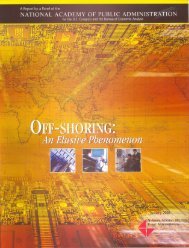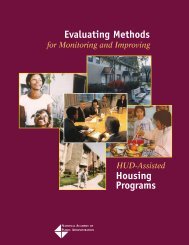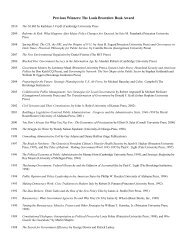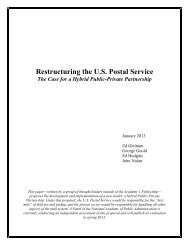High-Performance Partnerships - National Academy of Public ...
High-Performance Partnerships - National Academy of Public ...
High-Performance Partnerships - National Academy of Public ...
You also want an ePaper? Increase the reach of your titles
YUMPU automatically turns print PDFs into web optimized ePapers that Google loves.
CAREGIVER/EMPLOYER PROJECT<br />
CENTERS FOR MEDICARE AND<br />
MEDICAID SERVICES<br />
Rosalyn Carter once said there are four types<br />
<strong>of</strong> people: those who have been caregivers,<br />
those who currently are caregivers, those who<br />
will be caregivers, and those who will need<br />
caregivers.<br />
Research shows that one in four U.S. households—about<br />
24 million people—care for elderly<br />
family members or friends. Medical<br />
progress, coupled with the aging <strong>of</strong> the<br />
Boomer generation, will increase these numbers<br />
significantly during the next few years.<br />
The number <strong>of</strong> caregivers is expected to total<br />
39 million by 2007. Family caregiving now<br />
costs the equivalent <strong>of</strong> $200 billion annually.<br />
Sixty-four percent, or close to 15 million, caregivers<br />
work. Fifty-five percent report that<br />
caregiving impacts their work. They leave<br />
work early, arrive late, and miss days. On average,<br />
caregivers can lose more than $650,000 in<br />
wages, social security benefits, and pensions.<br />
Forty-five percent <strong>of</strong> employed caregivers<br />
spend one to five hours a week providing that<br />
care. Twenty percent spend 11 or more hours<br />
per week. Caregiving costs employers from<br />
$11 to 29 billion dollars per year.<br />
The Centers for Medicare and Medicaid<br />
Services (CMS) administers the Medicare and<br />
Medicaid programs. CMS communicates<br />
Medicare program information to 40 million<br />
aged and disabled beneficiaries. This challenge<br />
is complicated by population demographics.<br />
Medicare information must be understandable<br />
to older, sick, and disabled people with various<br />
levels <strong>of</strong> education, incomes, ethnic backgrounds,<br />
and languages. Although CMS pays<br />
for medical services, insurance is hard to<br />
understand. The dilemma is that people wait<br />
to get information until there is a problem.<br />
CMS has targeted caregivers as a key audience<br />
to educate so they can help people to learn<br />
about the Medicare program. Caregivers do<br />
not identify themselves as such. They perceive<br />
themselves as doing what is appropriate.<br />
Identifying and reaching caregivers is a challenge,<br />
but doing so through their worksite is<br />
an effective approach.<br />
In 1999, CMS established a Caregiver<br />
Workgroup composed <strong>of</strong> caregiver and related<br />
organizations, beneficiary advocacy groups,<br />
disease-specific organizations, government<br />
agencies, employers, employer intermediaries,<br />
and others. This workgroup’s goal was to<br />
develop effective methods <strong>of</strong> communicating<br />
Medicare information to beneficiaries. The<br />
primary recommendation was to develop<br />
Medicare information for employed caregivers.<br />
CMS partnered with these organizations and<br />
their affiliates to develop and test Medicare informational<br />
materials targeted to 15 million<br />
employed caregivers and employers. The partnership’s<br />
immediate objectives were to educate<br />
employed caregivers about the program and help<br />
them assist the people they care for in making<br />
informed decisions. Caregiver and employer<br />
partners develop and test the materials.<br />
Employer intermediaries distribute the materials.<br />
Partnership Characteristics<br />
The Caregiver/Employer Project illustrates the<br />
difficulties <strong>of</strong> operating in a national context.<br />
The partnership’s goal is very specific, but its<br />
structure and administrative and implementation<br />
approach are diffuse. CMS, Caregiver<br />
Workgroup members, and other national partners<br />
operate in tandem with local affiliates,<br />
employers, and employer groups.<br />
59 Powering the Future: <strong>High</strong>-<strong>Performance</strong> <strong>Partnerships</strong>









